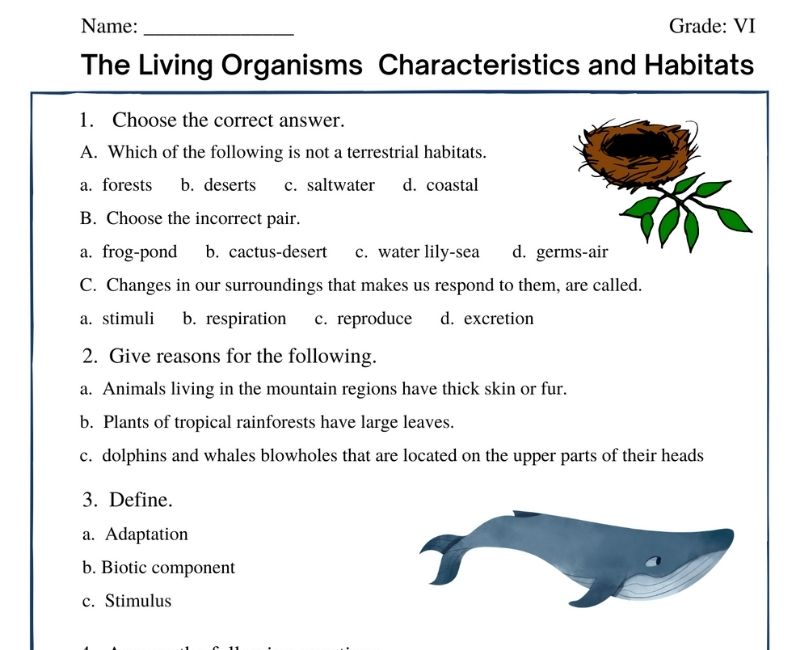The Living Organisms and Their Surroundings Worksheet
Dive into the captivating world of biology with the "The Living Organisms and Their Surroundings Worksheet," a gateway to understanding the intricate relationship between life forms and their habitats. This intriguing resource is more than just a series of pages—it's an expedition into the heart of ecosystems, where each question answered unveils how organisms adapt, survive, and interact with their environment. Picture yourself at the crossroads of curiosity and knowledge, holding the key to unlock profound secrets of life's interconnectedness.
The worksheet, designed for Class 6 students, transforms complex concepts into interactive learning experiences. With every flip, you'll discover meticulously compiled "The Living Organisms and Their Surroundings Class 6 Notes," which serve as a compass, guiding young explorers through the rich tapestry of biological diversity. From the lush canopies of rainforests to the mysterious depths of the oceans, these notes paint a vivid picture of the earth's biological wonders and the inhabitants that thrive within.
What truly elevates this worksheet are the "The Living Organisms and Their Surroundings Question Answers" sections, a treasure trove of dialogue between inquisitive minds and the intricate world of science. Each answer, crafted with care, doesn't just inform, it inspires, fostering a deeper appreciation for the natural world and the delicate balance that sustains life. This is not just an educational journey; it is an odyssey of wonder, where every student is not only a keen learner but also a custodian of nature's legacy. So, grab your worksheets, young explorers, and ready yourselves for an unforgettable adventure into the realms of living organisms and their wondrous surroundings.
Chapter Overview: Living Organisms and Their Surroundings
The chapter "Living Organisms and Their Surroundings" introduces students to the fascinating world of biology, focusing on how living organisms interact with their environment. It delves into topics such as habitat, adaptation, and the interdependence of life forms within various ecosystems. Through engaging content, students learn about the characteristics that differentiate living things from non-living, understand the concept of biotic and abiotic components, and explore the unique ways organisms adapt to survive in their natural habitats. This educational journey reveals the extraordinary diversity of life and the delicate balance that sustains ecosystems around the globe.
Witknowlearn Living Organisms and Their Surroundings Class 6 Worksheet
The Witknowlearn worksheet for "Living Organisms and Their Surroundings" is a meticulously crafted educational resource designed to complement Class 6 biology lessons. Through a series of interactive questions, engaging activities, and thought-provoking exercises, this worksheet plunges students into the depths of ecological concepts and life sciences. It empowers learners to explore real-world examples of adaptation, analyze the relationships within ecosystems, and critically think about how humans impact the natural world. By integrating visuals and hands-on learning approaches, it not only enhances comprehension but also fosters a lasting appreciation for nature.
Benefits of Living Organisms and Their Surroundings Class 6 Extra Questions
Incorporating extra questions on "Living Organisms and Their Surroundings" into class 6 science curriculum offers myriad benefits. These comprehensive questions prompt students to delve deeper into the subject matter, reinforcing knowledge through varied perspectives. They inspire critical thinking, problem-solving, and analytical skills, pushing learners beyond surface-level understanding. Furthermore, tackling these additional queries prepares students for academic assessments and builds confidence in their abilities to apply scientific concepts to everyday life. It’s an enriching way to promote curiosity and a profound respect for the diversity of life and its ecosystems.
Download The Living Organisms and Their Surroundings Class 6 PDF Notes from Our Website
For students and educators seeking a rich resource to enhance learning, our website offers downloadable PDF notes on "The Living Organisms and Their Surroundings" for Class 6. These comprehensive notes are a treasure trove of information, beautifully compiling key points, illustrations, and summaries of the chapter. Easy to access and user-friendly, the PDF format ensures that learning can happen anytime, anywhere, without the barrier of physical textbooks. Whether used for revision, homeschooling, or as supplemental material, these notes are a fantastic tool for anyone looking to deepen their understanding of the natural world and its inhabitants.






